
While much of the attention of this week’s new Dura-Ace R9200 & Ultegra R8100 Di2 product launches have been focused on the wireless and 12-speed access, far less has been written on the 2nd generation power meter. Likely because unlike the rest of the group set, the power meter isn’t available yet.
Still, it remained the part of the Shimano next-gen group set story I was most interested in, given the accuracy challenges the first generation Shimano Dura-Ace power meter had (the R9100P). Even more, if Shimano could rectify those issues while concurrently expanding it to Ultegra (as they are doing now with the R8100P), then that could make for a very compelling integrated power meter option on bikes.
Thus, I spent a chunk of the morning talking power meter tech with Shimano and their power meter team. In doing so we walked through their explanation of why the 1st generation units had the accuracy issues they did, what they’ve done to fix it in the 2nd generation, and then a slew of other technology features going forward leveraging Pioneer’s power meter technologies that they acquired nearly a year and a half ago.
Now, unfortunately Shimano did not have a rideable unit at Eurobike. In fact, if you look at all reviews of the new system, you’ll notice nobody has a power-meter equipped unit. Those will likely start making their way to reviewers in October, with widescale availability in December. Thus, while I don’t have any accuracy comparison data at this point, I am going to dive into what they did different with this unit.
What Stays The Same:
First up, some quick basics and related things about what stays the same with the R9200P from the R9100P. Oh, and a very brief primer on naming:
– Shimano R9xxxx series = Dura-Ace crankset without power meter
– Shimano R9xxxxP series = Dura-Ace crankset with power meter
– Shimano R8xxxx series = Ultegra crankset without power meter
– Shimano R8xxxxP series = Ultegra crankset with power meter
And then from a generational decoder standpoint:
– Shimano R9200 = This new Dura-Ace stuff
– Shimano R9100 = The last generation Dura-Ace stuff
– Shimano R8100 = This new Ultegra stuff
– Shimano R8000 = The last generation Ultegra stuff
Got all that? Probably not, it’s OK.
Here’s what’s stayed the same:
– 300 hour battery life same as before.
– Internal rechargeable battery is identical as before
– Weight remains of the same (though, the new crank arms are about ~60g heavier than before, depending on exact chainrings on them)
– Claimed accuracy of +/- 2% remains
– ANT+ & Bluetooth Smart power broadcasting (total power/power balance/cadence)
– Magnet still required on frame for determining cadence/position of crankarm
– Active temp compensation same as before
– The strain gauges are placed in the same spot as previous as well.
– Still a dual-sided system (both left and right crank arms have sensors on them)
– Still a fingerprint magnet and impossible to take non-shimmery photos of
In terms of claimed accuracy, while officially it’s +/- 2%, Shimano says in testing they’re seeing it closer to +/- 1% to 1.5%. Obviously, that’s something I’ll dig into in testing on the road.
What’s Changed:
Next up are the most important things – what’s changed. This is the area where Shimano focused the most on one key thing: Materials.
In my discussions with them, Shimano noted that with the previous generation unit (Gen1 on the R9100P), the power meter had to basically be ‘retrofitted’ onto the crank arms that the crank arm team had made. As a result, the materials and manufacturing process of both the R9100 and R8000 crank arms meant that power meter strain gauges had a very hard time being consistent on that material. This wasn’t just an issue for Shimano – but really everyone else. Be it Stages, 4iiii, or all companies adding power pods to the side of those two specific Shimano units (interestingly, this wasn’t an issue in previous generation Shimano crank arm sets).
Looking at the R9200/R8100 series however, Shimano says they worked as a cohesive team such that the materials and manufacturing process were designed to support power meter inclusion/addition, rather than be just ‘best effort’ as was the case on the previous design.
At one point during the discussion, one of Shimano’s leads noted that when it came to changes, they specifically “redeveloped the material of the crank arm itself to have better predictability of the strain gauges”. That’s notable, because the core challenge of the previous gen units was that the material wasn’t predictable, and thus, you saw variations from those cranksets (be it Shimano’s power meter or others).
Thus, in summary, here’s what’ changed on this unit from a hardware standpoint:
– Changed crank arm materials
– Changed crank arm manufacturing process
– Battery cap is now replaceable
– Battery is on side of spider rather than top
– Battery connector cable changed to match Di2 rear derailleur charger cable (so you only need one cable)
Also, while not changed, there’s a few quick things that are notable per se about the newer units:
– Both the Dura-Ace & Ultegra power meter are identical. Only the underlying crank arm materials differ.
– Ultegra pricing is $1,160 for a dual-sided crankset with chainrings and power meter ($315 without power meter)
– Dura-Ace pricing is $1,470 for a dual-sided crankset with chainrings and power meter ($625 without power meter)
Of course, very few consumers will be paying those prices directly. Most will buy it via bikes that are pre-built, and thus, the actual costs are far lower.
What’ll arguably be just as interesting is whether or not 3rd party power meters (e.g. Stages/4iiii/etc…) have better luck on the newer cranksets than older ones. That’s ironically something we might know sooner than we know from Shimano’s own power meter. Merely because people can go out and buy a new R9200/R8100 equipped bike today. And thus, so too can companies like Stages. Therefore it won’t be long till they start testing their pods on those crank arms.
In any case, interesting times ahead for sure.
Oh, and for lack of anywhere else to put it, here’s a quick front and back shot of both units, starting with the Dura-Ace:
Ultimately, there’s really no visible differences here from the previous generation, aside from the connector and pod placement. And then, the Ultegra:
Virtually all the meaningful changes are under the hood…err..crank arm.
What’s Upcoming:
The last bit is what’s upcoming. And for that, we have to go back to the past. In this case, what’s old is new again. Shimano will be leveraging Pioneer’s pedaling efficiency metrics going forward in their power meters. However, the exact branding and precise features aren’t fully finalized yet. Still, Shimano’s goal is to have this out at the end of the year.
There’s a few notable bits within that. Right now they’re aiming to support some aspect of the ANT+ Cycling Dynamics standard (that’s part of the ANT+ power meter profile). While the standard won’t support everything that Pioneer had, Shimano said numerous times they want to support the standards here, so they don’t end up in the same situation as Pioneer with only a handful of people using the metrics since it relied on a Pioneer bike computer.
All of this will also upload to the new Shimano site. Yes, that one. Since we’re talking about that, they seemed to sorta sheepishly imply that what went down back in June was pretty much their worst nightmare. However, also a contractually obligated nightmare with Pioneer. In effect, that date was decided in a legal contract, and hell or high water, that was the end date. Both hell and high water came, and the site went down for…well…till the next month or so.
Nonetheless, it sounds like by ensuring open standards, they’ll be able to work with other players so that there’s not only no dependency on a given Shimano platform, but no lock-in with any given head unit manufacturer either. Also, that’ll probably give good reason for companies like Wahoo, Stages, and Hammerhead to fully support the cycling dynamics standard before Shimano users arrive later this year.
Wrap-Up:
I’m cautiously optimistic about accuracy potential on the new 2nd gen Shimano power meter. At no point during our conversation did Shimano shy away from the challenges and limitations they had trying to make the 1st gen unit ‘work’ on a crank arm that wasn’t designed for it. While the rest of the power meter industry had long come to the realization of this conundrum, Shimano hadn’t done so publicly prior. So for them to both explain the situation as well as how it changed going forward, that seems promising.
Also promising is their repeated insistence on following an ANT+ & Bluetooth Smart specs for advanced pedaling metrics as broadly as possible (within the limitations of the specs), which is also a good step forward. Shimano has a long history of beating to their own drum in the tech field, so trying to color within the lines would be much appreciated by both consumers and industry alike.
Ultimately, the next step is simply getting the R9200P & R8100P units into the DCR Cave and out onto the roads for more detailed testing. It’s really as simple as that. Hopefully that’ll start in October, and then be ready to release whenever Shimano confirms the product is final. As always, that’ll include both indoors and outdoor testing, in what is the typical craptastically rainy fall Netherlands weather. Ain’t no warm sunny locales here.
With that – thanks for reading!
FOUND THIS POST USEFUL? SUPPORT THE SITE!
Hopefully, you found this post useful. The website is really a labor of love, so please consider becoming a DC RAINMAKER Supporter. This gets you an ad-free experience, and access to our (mostly) bi-monthly behind-the-scenes video series of “Shed Talkin’”.
Support DCRainMaker - Shop on Amazon
Otherwise, perhaps consider using the below link if shopping on Amazon. As an Amazon Associate, I earn from qualifying purchases. It doesn’t cost you anything extra, but your purchases help support this website a lot. It could simply be buying toilet paper, or this pizza oven we use and love.

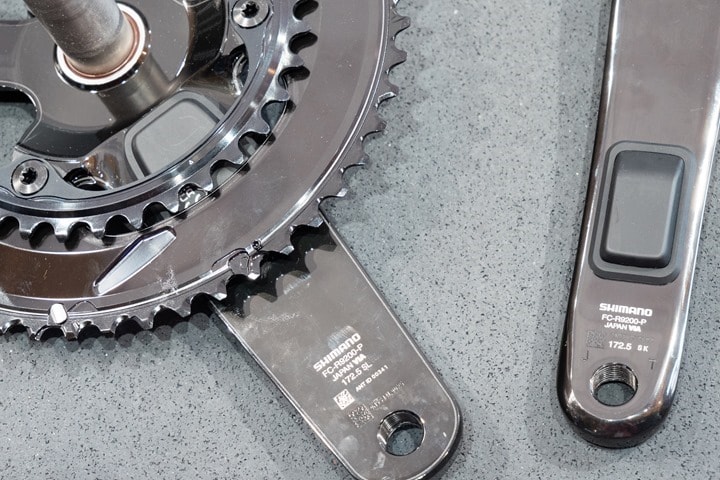
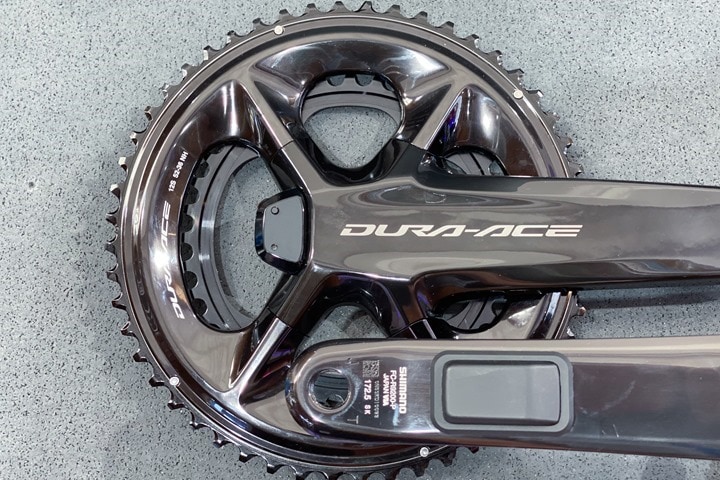
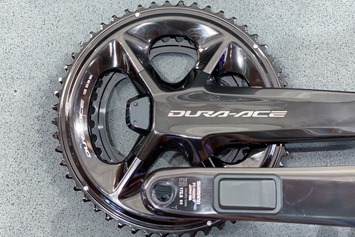
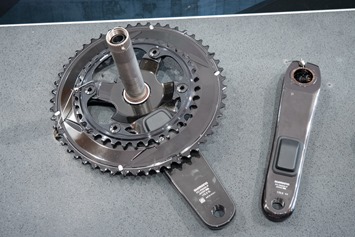
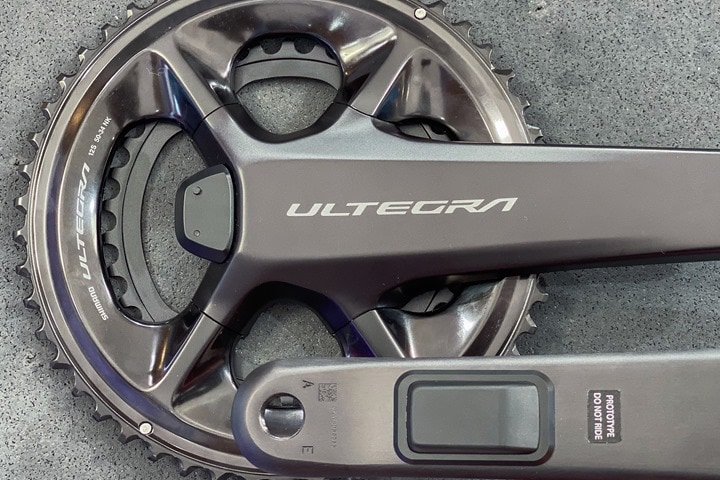
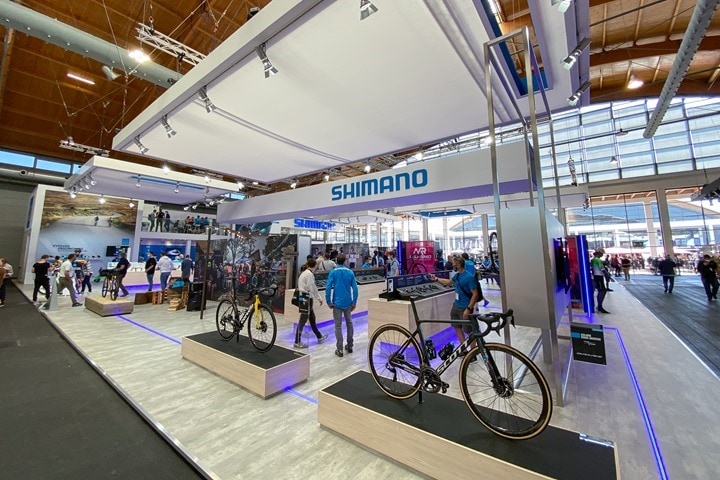
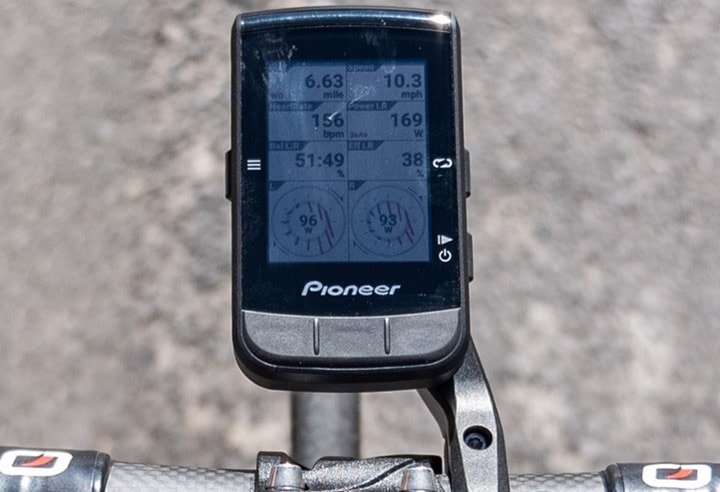




















Cadence magnet means a hard no for me. Looking forward to see how well quarq works with the new 12 speed drivetrain.
While I don’t disagree with the slight annoyance, I’d love to understand the hard no part (truly curious).
Cheers!
Just seems strange that all other crank based power meters use accelerometers. In 2021 it feels like table stakes – requiring a magnet feels like a shortcut. Makes me wonder what other shortcuts they took. And in all honesty from an ascetics standpoint – it will just be one of those things that would always bother me. Given all of the other great options, I can’t see a reason why to use Shimanos.
I had the frame magnet come off twice on the old Quarq Riken. 2nd time almost crashed as my drivetrain came to an immediate halt, while I did not.
I prefer not to have a frame magnet.
For all my sins I quite like the R9100p that I regularly use.
re: the annoyance of a magnet
My original magnet was white…which looked bad. even though only I noticed it.
i lost the chain a couple of weeks ago…di2 went into crash mode and wouldn’t shift and then, when i got that working, there was no power. took me an hour to figure out the magnet had come off as well. cadence feeds into the power calcs
later, it’s then a bit tricky (but entirely possible) to affix a new and fairly expensive magnet even tho the instructions seemed to say to remove the cranks.
finally, because of the magnet, there’s no sensible way to easily swap it temporarily to another bike.
I’m disappointed the magnet is on the new version as well, that’s one thing I hoped would go.
any chance you an add a picture of where the magnet sits on the bike? I don’t think i’ve seen any around with the riders i do see as most of them have moved to the quarq/axs groupsets.
this was mine when new. see if you can spot it
link to the5krunner.com
i have a black cover now ;-)
is it the white circular one behind the crank right next to the bottom bracket?
Correct. You can also see it (and all it’s ugliness) in this older review picture of mine too: link to media.dcrainmaker.com
thanks! doesn’t really look nice unless it can blend in with the bike. and as indicated in the other comments, if the magnet falls out then that’ll suck if it stops recording info at that time.
Hummm… looks like all those material and manufacturing issues may have something to do with the bonding process. The hollow arms are actually two pieces epoxy-bonded together. You may have heard about some pieces failing under (supposedly) high humidity conditions.
All of this makes sense, since the bonding area may be less predictable in terms of deformation under load. It’s a guess, I have no insights that support this. But I honestly hope that they have improved this for better durability and better power meter suitability.
“Materials” is just code for they made it symmetric with more defined arms to the chain rings to deal with asymmetry to axial / lateral forces and coupling issues due to gages on the inner surface and correction gages. It’s why the crank gained weight too because they couldn’t rely on asymmetric geometry absorbing the weight of a defined chainring arm by attaching it to the main crank arm.
Aluminum from a stiffness perspective from one series to another isn’t really different — not like yield / ultimate tensile strength is, fracture resistance, fatigure, etc, Stiffness and mechanical response is the same. Actually you can swap ANY metal in and it’s response will be the same scaling only by Elastic/Youngs Modulus. The bond line is very similar with the same improved consistency from the picture so from a mechanical engineering background “materials” is being used to mean “where material be at” which means Geometry.
When you’ve studied and invented tech used on these things you get a bit peaved with marketing wank.
Absolutely agree – spot on post!!
This is all about symmetry, and nothing to do with ‘materials’
In their defence, it’s a much simpler conversation to say “materials innit” than a lengthy explanation of how they changed the shape and why that might work. The general public will hear “materials” and accept it’s probably fixed, whereas design is a bit wooly and leaves it open for Internet debate and armchair engineers to paint a bad picture. It’s bad enough with all the nutters suggesting these cranks fall apart all the time, despite evidence that of the huge number of units sold only a few have actually failed. They’re darned if they do and darned if they don’t, so may as well keep the conversation short and snappy.
Hey Keith, nice insight. Thanks.
Not just that but material fatigue. For elite riders as myself I go through a crank arm in 20,000kms. As the material fatigues, the gauges cannot possible be reading accurately…
I’m at the opposite end of the spectrum from “an elite rider such as myself,” but I DID just survive a C2C3 cervical vertebral bodies “hangman’s fracture” when an inattentive motorist made a “right turn on red” against a light, catapulting me over the hood of her 2003 Pontiac to a faceplant on the pavement. And, if a broken neck weren’t enough, I gained a vocal cord hematoma (small, but with BIG temporary effects on my voice) and a HUGE hematoma on my R inner thigh which is STILL present almost 4 months later, albeit much smaller). After 6 weeks wearing an imprisoning “Miami” cervical brace, I finally found the right neurosurgeons (one on each coast), who both told me that I didn’t need EITHER the collar nor the C1 through C5 surgical fusion recommended by the guys at the end of my emergency May 31 helicopter ride, because I had the good fortune to be BORN with the C2 and C3 vertebral bodies fused together (Klippel Feil Syndrome), and that because of that I should throw away the collar, get some physical therapy to increase the range of motion in my still painful neck, and ride my bike. Of course, I no longer HAD a rideable bike (carbon fiber being a bit more fragile than the human skeleton).
Ultimately, I obtained a special “crash replacement” 2022 S-Works Roubaix DuraAce Di2 12 speed 9200-P from Specialized, but struggled to make the power meters work. Resolving THAT dilemma didn’t occur until I contacted Specialized Rider Care by phone and learned that my Di2 Groupset was NOT equipped with Shimano’s own dual meters, but with 4iiii’s Precision Pro dual meters, which of course can NOT be configured using Shimano’s horrible-UI “eTube Cyclist” iOS software, but require 4iiii’s own iOS app. I just this morning figured that out (aided, perhaps, by the 4iiii logos on the meters and their different locations on the L crank arm and the R spider). 4iiii’s app found them (and my Wahoo Kickr bike) virtually instantaneously via Bluetooth and paired them even faster. Now I need to wait for the rain to stop and the opaque air drifting eastward from Lake Tahoe to clean itself up a bit to take a brief ride to see if 4iii’s meters produce power numbers accurate to even ANY extent. Trying to add the meters to my Garmin 1030 using its embedded software, Shimano’s eTube Cyclist iOS abomination, coupled with random presses on the comm button on the rear derailleur just yielded various steady or blinking green or blue glows from the adjacent LEDs, plus shifter disconnects (AARRRGHHH!!!!).
OK, I did get the 1030 to acknowledge the presence of ONE meter, but if the 1030 were to be believed, my left leg was contributing NOTHING to my efforts.
Of course, this begs the question: Why on earth would Shimano buy another company’s (Pioneer’s) power tech to add to its own product line, then many months later sell group sets to a not-insignificant customer bike manufacturer (Specialized), still equipped with 3rd party meters? Possible explanations:
1. Shimano doesn’t really trust its own stuff yet.
2. Shimano (or Specialized) recognize that 4iiii’s stuff is cheaper AND probably works better.
3. (Add your own speculation).
And, just to soften the chorus of “you idiot, can’t you see? The different logos, different positionings of pods on the bike, should have been enough to clue you in!!!” When I went back to the local shop that built my bike (which I absolutely LOVE, by the way—both the shop AND the bike), their head techie mechanic made the same mistakes I did (using eTube rather than 4iiii’s software. However, at least he was able to make my shifter’s work again.
I’m also a bit disappointed with the magnets. Did they give any indication if it will be similar to the old Pioneer units where a magnet is required for advanced metrics, but you can run it without the magnets for basic power? If so that would make the magnets optional and everyone can choose advanced metrics or aesthetics. Curious if you know more?
Could Shimano just open the Pioneer standards and just used PM’s that worked really well?
“As a result, the materials and manufacturing process of both the R9100 and R8100 crank arms”
R8000, surely? (ie: possible typo alert.)
Looking forward to the final review, though given that I already have Quarq cranks on my two main bikes (not my commuter, I can’t justify over a thousand bucks Australian on a power meter for the commuter) I’m not likely to buy any time soon.
I hope that Shimano corrected the issue with 9000/8000 crank arms separating at the seem and cracking. There were enough cases just in my little group that it probably should have been a recall.
I’m also surprised and disappointed that Shimano didn’t develop a pedal-based power meter. Their platform is so popular that Garmin developed the Rally version.
Will these be compatible with R9100/R8000? Obviously there’s a limit to how interchangeable parts can be from a 12-speed and an 11-speed groupset, but if I’m running Ultegra R8000 and these power meters work well, is there any reason I couldn’t swap out the R8000 for R8100 cranks?
Thanks Ray! Great deep dive without the unit. Love your approach to this. Can’t wait unit you test the unit.
All this talk of availability in October is hilarious. I needed a good laugh so many thanks Shimano. I don’t own any SRAM but every time a new drivetrain is announced, I get emails same day from online shops saying it is in their warehouses for immediate delivery. It’s just too hard for Shimano.
To be fair – Ray was talking about power-equipped sets when he mentioned October availability. I’ve checked a local bike shop and they have regular (non-power) Dura-Ace and Ultegra groupsets “available next week” but there’s no mention of the ones with integrated power meter.
Correct. I specifically noted December availability for power meters to consumers, and October is likely for when I’ll have hands-on with one (power meters).
As Pavel noted, non-power meter units are out there basically immediately.
As for SRAM, it’s honestly not much different. One only need to look at the SRAM RIVAL power meter-equipped crankset earlier this year to see availability was identical to how Shimano is doing this.
“materials and manufacturing process of both the R9100 and R8100 crank arms meant that power meter strain gauges had a very hard time being consistent on that material.”
Hi Ray, it should say “R8000” here, because previous version
:O)
Thanks!
That pricing is absolutely brutal. Obviously very few are going to buy it at that price and that weight for custom builds. But it’s a real kick in the balls for those buying a complete bike with non-P and wanting to then swap out to P later – keeping it Shimano … that doesn’t seem like an option for any except those with the deepest pockets.
On another note, any news on if new Ultegra or DA will work with 11s cassettes? Those 12s cassettes are going to be like hen’s teeth for a while.
I thought the whole “problem” with 9100P/8100P is/was the asymmetric spider arms. Has that question been resolved?
Ray, when you get it can you please test the following types of scenarios?
1. Changing temperatures (indoor to outdoor) and heading off riding quickly
2. riding in cobbles or bumpy roads
And other common but not smooth situations
Thanks Ray, good review. So if its the crank materials and manufacturing process that caused gen 1 to be flaky, shouldn’t that have also been seen as an issue on 4iii and stages?
What am I missing?
Yup, it was actually seen. However, it was also variable. Which is why it impacted some units coming off the line more than others.
I WANT TO HELP. MAKE THE DONATION SITE MORE USER FRIENDLY
Shimano can be inscrutable at times but all the recent information about the new groups seems promising. I do still hope they have some quirky & unexpected things going on. Conventional counter attacks against SRAM work to.
Great article!! Looking forward to your review from trying it on the road!
From the video it looks like Shimano have developed a “STAIN GUAGE.” Is this to measure your skid marks or perhaps it is just one of those predictive text mishaps?
I think killing one of the best bike computer was the biggest mistake by Shimano. I was so happy with my CA600 performance especially with its easy configurable screens.
I transferred my data to new Shimano web site but it is still not clear if I think upload my ride data automatically. Does anyoine have insights on that?
Ray, are you still linked up with Clever Training? I am making a big purchase and wanted you to benefit.
Hi Kirk-
No, we parted ways about a year ago now. These days using the links on the side for CompetitiveCyclist.com, Backcountry.com, or REI.com are the best bets to support the site.
I appreciate thinking of me!
Cheers!
So will the K-Edge chain catcher with magnet work for this and be a ‘fix all” ??
“the materials and manufacturing process of both the R9100 and [b]R8900[/b] crank arms”
Ray, I think you’ve fixed a typo there but replaced it with another typo. (Done it myself; every journo’s nightmare)
Doh, thanks!
Good morning!
Can you post a closeup of the open battery charge point cover and how it hinges?
Also, is it still possible please, to fasten the magnet to the frame without removing the crankset? it used to be possible to do that through the gap now occupied by the battery charge point.
Here ya go (attached).
As for inserting the magnet, not sure on that one till I get a unit on-hand.
I just bought 4iiii PM dual sided Dura ace 9100. I was not aware of accuracy issue. What exactly is the issue? are the measurements inaccurate all the time or only in specific situations? thanks.
This makes me a bit sad as I just bought the previous-gen unit last year. I haven’t seen large inaccuracies when comparing to my previous PM, but at the same time I would love to see a discount at least on the new meters for those who have the older models. Ray, any chance of that?
Also, count me as another one who had the magnet pop off: when my chain dropped and it jammed, I had to use significant force to pop the chain back out and apparently the magnet went flying off into the bushes. It’s a bit ridiculous that the entire meter stops sending info when the cadence magnet is lost! And of course they were back-ordered…my LBS gave me a temp magnet from another manufacturer and it worked fairly well. And when the shipment came in, it was only the white ones…which look terrible on my carbon-fiber Felt bike :-(
It appears that Giant AU has announced TCR Advanced SL Disc 0 Dura-Ace with the new Dura-Ace groupset and power meter. Hopefully other bike manufactors will be announcing updates with the new groupset soon.
Are the Dura Ace 9200 chainrings compatible with existing power meters such as the Quarq DFour DUB or the POWER2MAX NG 4 bolt Shimano 110 bcd?
As a long term Pioneer Pedaling Monitor System user I’m happy to see some of Pioneer’s IP is carried on in the next generation Shimano Power Meters.
Of course I had some question marks on how the Shimano Connect Lab piece would fit in the overall Shimano puzzle and more importantly in the cyclist-power-meter-ecosystem.
On an abstract level it feels like the Pedaling Monitor System (powermeter, headunit and webservice) is going into its next iteration in an open ecosystem instead of a closed one like Pioneer’s.
I will follow your tests and experiences Ray, and thanks for your initial view on the powermeters.
I think they first need to solve the issue that their cranks simply fail, i would say without a warning but if you have a powermeter enabled crank then with a warning.
My Shimano Dura-Ace Powermeter (1st Gen) failed on me during a downhill, after 3 years of use (out of warranty, such a shame?) it started having weird power numbers and having a 80/20 L/R avg balance, then a week later the left crank arm simply snapped around the pedal area, to my surprise this has happened to alot of people, the crank is out of warranty and i just lost my powermeter as well, so perhaps they should invest more there before releasing a powermeter or atleast give the powermeter a longer warranty as the price is much higher than just a crank.
excellent preview, as usual. The problem with these dual sided power meters (PM) is crank life. Shimano told me that, at power, 35km hr + and 75-80kg rider and gear, the DA crank is indeed expected to fatigue. Chainrings wear by 15,000 kms (tops), and crank, implacably, 20,000 kms. Put in a new one and the stiffness and speed gains (0.5-1 km/hr say it all. Last year I wrote a short WW article on the benefits of crank replacement. Yes, DA is amazing, but like all materials, it softens with lifecycles. Speedplay Pedals? 30,000-35,000 kms to slight flex. Now, folks WHAT DOES THAT DO TO THE PM? Presumably, on a left side PM, you can replace the crank. On the current new PM, you have to disregard it past 15,000 kms (1-2 seasons for a rider that uses two bikes only)… In the ned, I push and push my limits, hover at high speeds and no PM (be it the better way to measure effort). Man I wish these things remained hub or pedals based…
Thank you to the comments section for this info about magnets. I’ve been considering what to do with a new bike purchase and this helps a lot. Specifically, I won’t worry about getting a Shimano installed PM. I’ll just send my new 8100 crank off to 4iiii and get a superior PM with the fairly safe assumption that the R/L balance issues will be fixed.
Ray–Any update on this? Looking at getting a new bike. Leaving aside supply chain issues–eTap Force with a Quarq pm or Di2 Ultegra with a Shimano pm?
Given that the Power Meters obtain cadence data, do you know if they can send that data to the cadence data field in a Garmin 1030? I ask because I lost my 2018 S Works Roubaix Dura-Ace Di2 when hit by a car May 31. (Front wheel rim cracked, about a third of front spokes burst out of rim, carbon saddle mounting rails cracked, down tube cracked, rear derailleur hanger bent, possible other damage, too. My Edge 1030 itself was not damaged; I don’t know about the speed sensor, but I think that data can be calculated by the head unit based on GPS data.
Oh, the woman who hit me was turning onto a MT State highway from a side street against a red light; however, according to the Montana Highway Patrol officer who “wrote up” the crash, it was my fault, because once I knew the light would remain red from the cross street intersecting the highway (I was riding on a bike path paralleling the highway and separated from it by a grass buffer of about 10 ft width), I did not stop, dismount from my bike, activate manually triggered walk/don’t walk lights that shine “don’t walk” continuously UNLESS manually triggered.
Consequences for me? C2/C3 vertebral body fractures with fracture fragments propelled posteriorly into the spinal canal, BUT, fortuitously, I was born with the C3 and C3 vertebral bodies fused together (Klippel Feil Syndrome, which can cause neck stiffness and other problems if associated with other congenital anomalies). That fusion was not disrupted by the crash/fractures, so the broken neck didn’t kill me or paralyze me, as I assume is a significant risk, given that it’s called a “Hangman’s Fracture).
I asked the same question on your discussion of the Hammerhead/Shimano battle. No need to answer twice.
Thanks so much,
Jim Robertson
I have a Quarq power meter on my main road bike (and another one on my time trial bike). I only need to link it as an ANT+ power meter, and my Garmin grabs the cadence data from it without any issues; no cadence sensor required. The same applied to the Vector pedals when I was using those (I wanted to shift back to Shimano cleats, so Vector 1 and 2 were out, and I wanted to maintain CR2032 batteries for all my sensors where possible, so the Vector 3 was undesirable.)
The speed sensor is more accurate than GPS speed, because it comes direct from the wheel, whereas GPS data is dependent upon having access to GPS satellites (so tunnels, deep valleys, and similar will see you having mildly inaccurate speed data.) Whether that’s a concern to you or not is your call to make.
Glad you escaped without paralysis or death – sounds like a nasty accident. Good luck with your recovery.
Thanks for the follow-up.
I’m due to pick up my new bike this afternoon. I know the speed sensor i more reliable (once calibrated) than the GPS data, especially since the Garmin Software doensn’t include time stopped in callibrating average, let alone instantaneous speed.
I’m certainly even happier than you that my injuries weren’t worse. I’m now 2.5 months out and still have pretty significantly limited neck rotation. I don’t know if that’s permanent, related to displaced bone fragments, or whether is’s primarily spasm of cervical skeletal. Muscles because of the infamous “Miami” collar/brace. I’ve known since 1st year med school that I hav a modest cervical-thoracolumbar kyphoscoliosis, but never really understood just how crooked I was until I had to wear that brace for two months. Every time I adjusted it to look straight, my neck would hurt a bit more, and within an hour the bottom of it was always pointing towards my right little toe. Tanking that thing OFF was a signature moment!
My parents are resting in a cemetery in Michigan’s Upper Peninsula. All the time I was growing up they tried multiple reward/punishment techniques to get me to “improve my posture.” If the UP weren’t so remote, I’d make a minor modification of their resting place (in good humor, of course). I’d interpose one of my CT reconstruction of the chicanes in my spine between their gravestones, accompanied by inscribed text, something akin to “Stand up STRAIGHT” my ASS”😎❤️
Hi Ray,
I think about buying a new Canyon Speedmax and they come equipped with a FC R-8100-P Powermeter. Did you have the chance to test them if they are reliable now? The alternative would be a SRAM Force eTap AXS Powermeter but then I have to change the cassette at my trainer and can’t control my Garmin Edge with the shifters…
Cheers, Sebastian
I think you have tagged this deep-dive incorrectly. Should be R8100P instead of R8200P
According to GPLama, they have gotten even worse than the earlier 11 speed ones. Yikes…
Hi Ray,
My Dura Ace Power Meter left arm connector has died. I wonder if an Ultegra left power meter arm would connect up and work with my Dura Ace right side?
Or maybe I should just buy a set of Wahoo PM pods as all my pedals and cleats are already SpeedPlays?
I would appreciate any help you can give.
Thanks for the great site, btw.